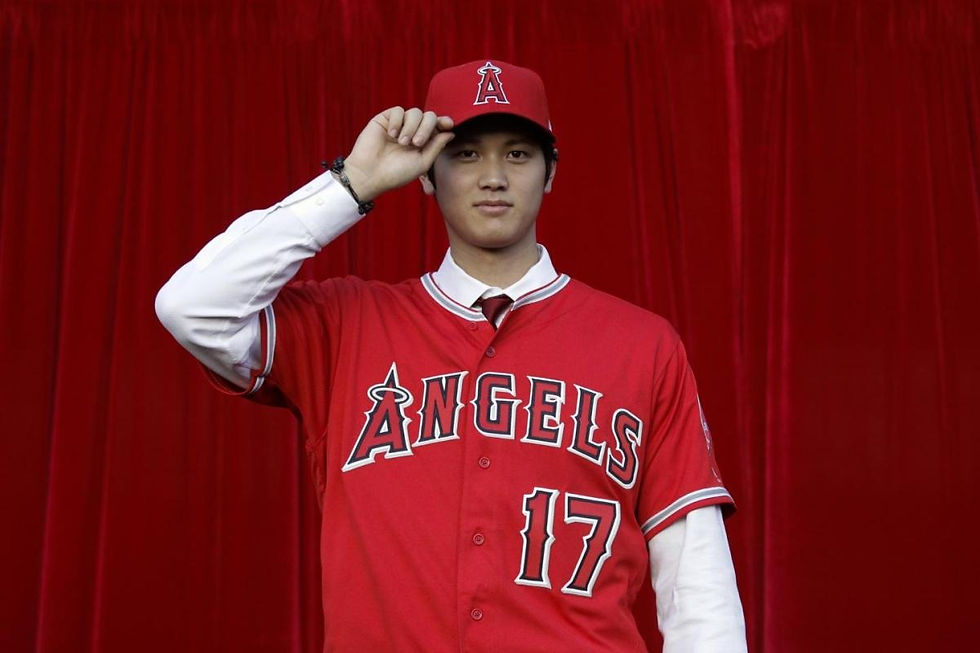Are We Overhyping Shohei Ohtani?
- Hamsky

- Feb 17, 2018
- 4 min read

After a long off-season, I’m happy to say it: baseball is back. Pitchers and catchers have made it to their Spring Training sites, while positional players are due to arrive tomorrow and Monday.
This off-season's “hot stove” of MLB free agency has been quite cold mostly, but has gone through some hot flashes; former Dodgers star pitcher Yu Darvish recently signed with the Chicago Cubs, while the Yankees are looking to buy another championship by acquiring former NL MVP and 59 home run slugger Giancarlo Stanton in December. In other news out of the AL, the Boston Red Sox front office seems to be complacent with slowly and gruelingly letting J.D. Martinez slip away.
On top of it all, with the return of baseball comes the return of the rookie spotlight. Most often, the rookie spotlight is shone on top prospects who are expected by fans to get called up from the minors. This year, however, all eyes in Anaheim are on Shohei Ohtani, the Angels’ newly acquired two-way player from Japan. The Angels turned the hot stove to 'high' when they won the league-wide bidding war for Ohtani and signed him to a minimum contract.
Ohtani comes to the MLB as a highly touted right-handed pitcher with a 100 MPH fastball and a sweet left-handed stroke in the batter’s box. In Japan, he played five seasons and, in his best season, posted a .322 batting average with 22 home runs while boasting a 1.86 ERA and striking out 174 batters across 140 innings.
Now, don’t get me wrong, these stats are absurd. But with every hype train comes the big comparisons. Typically, you get people comparing MiLB prospects to current MLB players, but now Ohtani enters the majors as the “Japanese Babe Ruth.”
“He's going to get the most looks as a pitcher… But that's not to say he won't have a chance to be a difference-maker on the offensive end, too...” (Angels’ manager Mike Scioscia on Shohei Ohtani)
While the Angels plan to utilize Ohtani as a pitcher first (MLB.com has him at third in the rotation), it appears that they will use him as a designated hitter when he’s not pitching. Ohtani played outfield in Japan, but I wouldn’t expect the Angels to risk his injury by tossing him in the field, and the Angels already have one of the best defensive outfields in the league.
The hype surrounding Ohtani is warranted; he will be the first official two-way player the MLB has had quite some time. And from what I’ve seen, he has definitely shown signs of being a special player, but let’s pump the breaks on the Babe Ruth comparisons and see how this experiment plays out.
I’ll be the first to admit that I’m excited to see Ohtani play. Do I think he will be ultimately good for the game if he plays well? Yes. However, I think that there is something to be said about foreign players who come to the MLB and stink. Remember Daisuke Matsuzaka? Sure, he was good for a year or two; Dice-K put up good numbers in 2008, but after that season, he truly fell off the face of the planet. I’m sure you don’t remember Kei Igawa, the Yankees’ rebound chick after missing out on Dice-K. New York gave Igawa $46 million to play 16 games and post a 6.66 ERA over 73 innings.
To the point of Ohtani’s skills, plenty of MLB pitchers both today and in the past can consistently hit 100 MPH. Just because a guy throws hard certainly does not qualify him as a top-tier pitcher; just ask Nathan Eovaldi; Arquimedes Caminero; and Bruce Rondon, some 100 MPH pitchers in the big leagues. Absolute no-namers.
Furthermore, Ohtani’s bat may not be as ready for the MLB as many scouts are letting on. I would contend that hitting in the NBP (Japan’s national baseball league) is significantly easier than in the MLB for several reasons. First, Japanese NBP fans lust for the long ball. Home runs have become so instrumental to viewership that many teams in Japan have shortened their fences to make hitting home runs easier. In addition, pitching is lower quality in Japan. In fact, the 26 fastest pitchers in the NBP throw at an average velocity of 87.0 MPH, while the top 26 fastest in the MLB average 98.2 MPH. Actually, Ohtani, himself, holds the NBP record for fastest pitch at 100.7 MPH, so to expect him to bat against an average velocity of 11.2 MPH less in Japan and transition seamlessly and successfully to MLB speed may be a little far fetched.
Trust me, I’m excited to see how a two-way player in the MLB will turn out, but history does not favor Ohtani, considering the most notable modern two-way baseball players you haven’t even heard of. I’ve always loved the utility player designation, and for that reason, Brock Holt will forever hold a special place in my heart. However, in terms of pitching and designated hitting, I wouldn’t be outright shocked if Ohtani bats .205 and logs a 5.80 ERA, thus ending the Japanese Babe Ruth experiment.
(Photo via NYDailyNews)







Comments